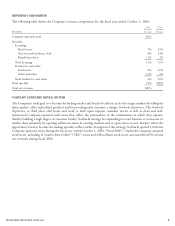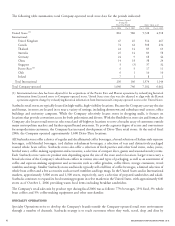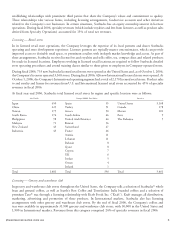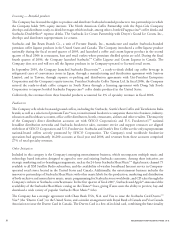Starbucks 2006 Annual Report Download - page 17
Download and view the complete annual report
Please find page 17 of the 2006 Starbucks annual report below. You can navigate through the pages in the report by either clicking on the pages listed below, or by using the keyword search tool below to find specific information within the annual report.Many of the risks and uncertainties of doing business in China are solely within the control of the Chinese government.
China’s government regulates the business conducted by Starbucks through its subsidiaries, joint ventures and authorized
licensees by restricting the scope of the Company’s foreign investments within China and the food and beverage, retail,
wholesale and distribution business conducted within China. Although management believes it has structured the
Company’s China operations to comply with local laws, there are substantial uncertainties regarding the interpretation
and application of laws and regulations and the enforceability of intellectual property and contract rights in China. If
China’s governmental authorities were ultimately to conclude that Starbucks has not complied with one or more existing
or future laws or regulations, or if their interpretations of those laws or regulations were to change over time, the
Company’s affiliates could be subject to fines and other financial penalties or forced to cease operations entirely.
Moreover, it could adversely affect the Company’s business if it is unable to enforce its intellectual property and contract
rights in China’s courts.
Additionally, Starbucks plans to enter selected markets in other developing countries (such as Russia and India) as an
important part of the projected growth of the International operating segment. Some of those markets pose legal and
business challenges similar to the China market, such as substantial uncertainty regarding the interpretation and
application of laws and regulations and the enforceability of intellectual property and contract rights.
• Effectively managing the Company’s rapid growth is challenging.
The Company’s long-term goal is to open approximately 20,000 Starbucks stores in the United States and at least 20,000
stores in International markets. Starbucks expects annual total net revenue growth of approximately 20% and annual
earnings per share growth of approximately 20-25% for the next three to five year period. Effectively managing growth on
this scale is challenging, particularly as Starbucks expands into new markets internationally, and it becomes increasingly
difficult to ensure a consistent supply of high quality raw materials, to hire sufficient numbers of key employees to meet
the Company’s growth targets, to maintain an effective system of internal controls for a globally dispersed enterprise and
to train employees worldwide to deliver a consistently high quality product and customer experience. Achieving the
Company’s growth targets is also dependent on its ability to open more new stores in the current year as well as future
years than it opened in prior years.
• The loss of key personnel or difficulties recruiting and retaining qualified personnel could jeopardize the Company’s
ability to meet its growth targets.
The success of the Company’s efforts to grow its business depends on the contributions and abilities of key executive and
operating officers and other personnel. Starbucks must continue to recruit, retain and motivate management and
operating personnel sufficient to maintain its current business and support its projected growth. A shortage or loss of
these key employees might jeopardize the Company’s ability to meet its growth targets.
• Starbucks faces intense competition in the specialty coffee market.
There are numerous competitors in almost every market in which Starbucks operates and in which it expects to expand in
both the specialty coffee beverage business and the specialty whole bean coffee business. This is especially true in the
major metropolitan areas where Starbucks operates and expects to expand, in virtually all of which there are local or
regional competitors with substantial collective market presence. Although competition in the specialty coffee beverage
market is currently fragmented, competition is increasing, particularly from competitors in the quick-service restaurant
sector who are focusing on growing the specialty coffee beverage part of their businesses. A major competitor with
substantially greater financial, marketing and operating resources than Starbucks could enter this market at any time and
compete directly against Starbucks. The Company’s whole bean coffees compete directly against specialty coffees sold
through supermarkets, specialty retailers and a growing number of specialty coffee stores. Some of the Company’s
competitors in these whole bean specialty coffee distribution channels have greater financial and marketing resources than
Starbucks. Both the Company’s whole bean coffees and its coffee beverages compete indirectly against all other coffees on
the market. Starbucks also faces well-established competitors in many international markets. If Starbucks fails to maintain
STARBUCKS CORPORATION, FORM 10-K 13
























